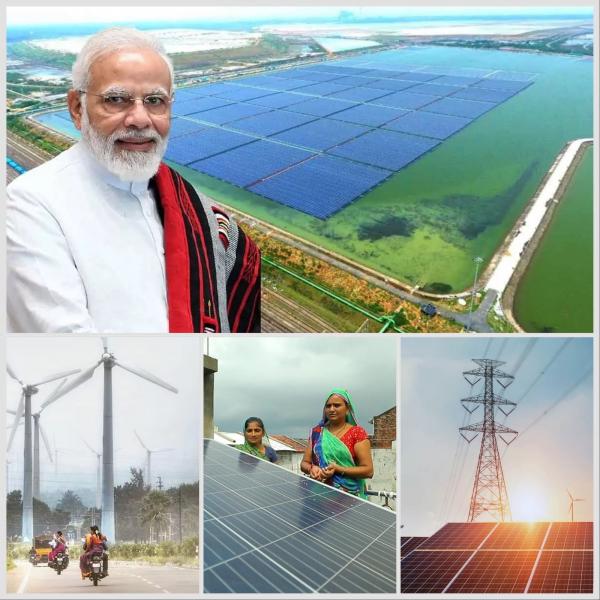
What is the Third National Communication India shared with the UNFCCC
10/12/2023
BLOG
On December 9, as discussions and negotiations at the 28th Conference of Parties were going on, India shared its National Communication (NC) with the UN Framework Convention on Climate Change based on Greenhouse Gas (GHG) inventory of 2019 along with Initial Adaptation Communication.
India’s commitment to following a lifestyle based on sustainable practices is evidenced from the fact that our per capita carbon footprint is 60% lower than the global average, a manifestation of the principle that drives Mission LiFE – Lifestyle for Environment.
India is one among 26 developing countries which have submitted their communication based on GHG inventory of 2019 or later years.
The Convention, in accordance with its Articles 4.1 and 12.1, enjoins upon all Parties to furnish information in the form of a National Communication regarding the implementation of the Convention. The Convention aims at stabilizing the GHG concentrations in the atmosphere at safer levels that would prevent alarming anthropogenic interference with the climate system.
Between the 2015 Paris Agreement and COP28 underway in Dubai, India has made significant strides towards combating climate change through a multi-pronged, multi-sectoral approach.
The Communication shared by India yesterday, underscores our consistent contribution towards climate action while also prioritising the developmental aspirations of its 140 crore people. The NC highlights that the area of India is almost 2.3% of the world’s land area. It is the 7th largest country in the world and it is home to one-sixth of the world’s humanity. India is home to 18% of the global population but is responsible for less than 4% of the global cumulative CO2 emissions between 1850 and 2019. To meet the needs of one-sixth of the humanity is the foremost priority of the PM Modi-led government.
This tall task poses its own challenges before the Nation. The challenge is to be able to maintain a sustainable development pathway and to harness its resources efficiently.
Hon’ble Prime Minister Shri Narendra Modi has time and again stressed on the fact that we will march into Amrit Kaal focusing both on ‘economy and ecology’. The important feature of this developmental model is the continuous reduction in the emission intensity of the economy which is the total amount of greenhouse gas emissions emitted for every unit increase of Gross Domestic Product (GDP).
The NC mentions that India’s GDP between 2005 to 2019 has grown with Cumulative Annual Growth Rate (CAGR) of about 7%, whereas the emissions grew at a CAGR of about 4%. i.e., the rate of growth of emissions is lower than the rate of growth of our GDP. This shows that India has successfully continued to decouple its economic growth from greenhouse gas emissions, resulting in the reduction of the emission intensity of its GDP by 33% between 2005 and 2019.
We are proud to have achieved our original target of reduction of emission intensity by 33-35% over 2005 level by 2030 11 years in advance. As a responsible global partner, India has already revised the target of reduction of emission intensity by 45% by 2030, over 2005 level, in its revised NDCs submitted last year.
India’s share of non-fossil sources based installed capacity of electricity generation in 2023 is more than 41%. India achieved its NDC of 40% cumulative electrical power installed capacity from non-fossil fuel-based energy sources in 2021, 9 years ahead of the target date of 2030.
During 2005 to 2019, an additional carbon sink of 1.97 billion tonnes of CO2 equivalent has been created. We are well on track to achieve the target of creation of additional carbon sink of 2.5 to 3.0 billion tonnes through tree and forest cover by 2030. The NC shares GHG emissions for the year 2019 in India and informs that the energy sector contributed the most to the overall anthropogenic emissions (75.81%), followed by the agriculture sector (13.44%), Industrial Process and Product Use (IPPU) sector (8.41%), and Waste (2.34%).
The Land Use, Land-Use Change and Forestry (LULUCF) sector remained a net sink in 2019, accounting for the removal of 4,85,472 GgCO2e of emissions. Considering total emissions and removals, India’s net national emissions in 2019 were 26,46,556 GgCO2e (or 2.6 billion tons CO2e). Out total national emissions (including LULUCF) have increased by 4.56% with respect to 2016.
Our NC also details the steps being undertaken by India is making efforts for the upscaling of renewable energy resources. Our commitment to clean energy become evident through substantial investments in solar and wind energy projects. India’s solar energy installed capacity has grown nearly 20-fold in the last nine years.
Relative to its responsibility and relative to what equity demands, India is contributing far more than its fair share in emission reduction.
Apart from championing and safeguarding the tenets of multilateralism, India is hosting, supporting and nurturing the International Solar Alliance (ISA) and the Coalition for Disaster Resilient Infrastructure (CDRI) as a part of its commitment towards reducing emissions and towards strengthening its adaptation efforts.
The most significant aspect of our climate action is the fact that our achievements have been made through our own financial and human resources. The scopes of these achievements can be enlarged many times over if the developed countries walk the talk on financial assistance, technology transfer and capacity building needs are met.
The developed countries must fulfil their commitments of 100 billion USD per annum under the Convention.
Meanwhile, focusing on climate action at home, the Ministry of Environment, Forests and Climate Change has brought out a publication titled, ‘From Paris to Dubai: India’s Climate Journey’, which throws light on India’s climate agenda and progress in its climate action as India powers on taking 1.4 billion people towards achieving sustainable development goals. The publication offers a sector by sector detailing of how India is moving on the path of sustainability.
Initial Adaptation Communication (IAC)
As part of our global obligation and following the procedure laid down in Article 7.11 of the Paris Agreement, the National Communication shared by India also carries a special Annexure on India’s Adaptation Communication which gives details of Adaptation measures undertaken by India.
Under the leadership of Hon’ble PM Modi, India has been diligently working towards adaptation. Several policies and measures have been put in place across key economic sectors, keeping in mind the wide scope of adaptation activities. India has been spending significant amount of resources on adaptation relevant actions. We have managed to do this despite the competing demands for limited resources by virtue of being a developing economy.
In India, public finance covers most of the adaptation-based activities through flagship programmes, schemes etc. Around 40 Ministries have adaptation relevant budgetary provisions. The total adaptation relevant expenditure was 5.6% of the GDP in 2021-2022, growing from a share of 3.7% in 2015-16.
There, however, remains a significant gap in adaptation resources which cannot be met only through governmental resources. Considering the increase in the adverse impacts of climate change as well as costs of resilience measures, significant contributions need to be channelized through bilateral and multilateral public finance and private investments.
While we make these significant policy reforms and stand proud of many of our achievements, we remain mindful of the crisis staring at us. Hon’ble PM Modi has thus raised a clarion call to make environmental consciousness a mass movement. Launching Mission LiFE, PM Modi stated that there is a need to move away from the path of mindless and destructive consumption and production towards mindful and deliberate utilization of resources which is at the core of the behavioural change required on the part of each and every citizen for combating climate change.
Even as India makes all possible efforts at home and forges global associations towards a sustainable future, it continues to reiterate that the goal of environmental sustainability can be achieved only through the principle of climate justice which focuses on protecting the poor, marginalised and vulnerable people of the world from the adverse impacts of climate change.
For impactful climate action, technology transfer and climate finance cannot be further delayed.
